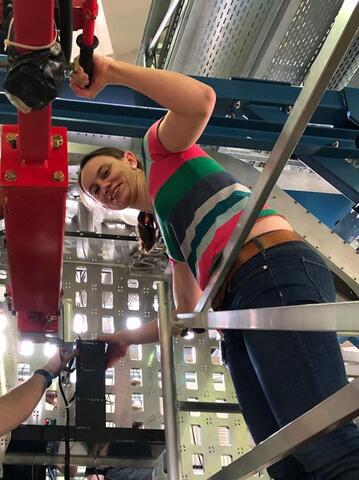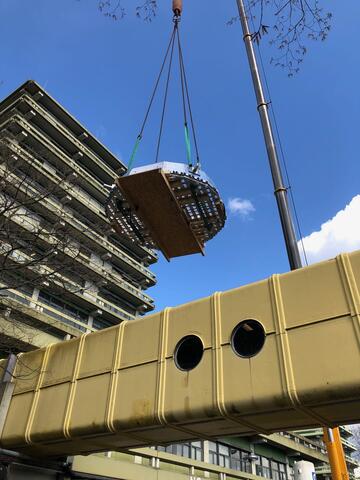Workshop „Physics Opportunities with Proton Beams at SIS100” was held in Wuppertal
PANDA meetings
04/03-08/03 2024 CM 24/1 in Münster
24/06-28/06 2024 CM 24/2 at GSI
25/06-26/06 2024 FEE/DAQ Workshop
04/11-06/11 2024 CM 24/3 at GSI
05/03-07/03 2025 WS at GSI
16/06-20/06 2025 CM 25 in Uppsala
Development of the Fast Timing Panda Barrel Time-of-Flight Detector
Sebastian Zimmermann
TH-PHD-2021-001.pdf
(61.35 MB)
The Barrel Time-of-Flight Detector (B-ToF) is a timing detector for the Panda
experiment which is currently under construction at the Facility for Antiproton and
Ion Research (FAIR) in Darmstadt, Germany. In fixed target p̄p collisions, with
antiprotons accelerated up to a momentum of 15 GeV/c producing a center of mass
energy of up to 5.5 GeV, open questions of hadron physics will be studied. This
effort includes charmonium spectroscopy and the search for exotics and hybrids
as well as the study of hypernuclei and of hadrons in matter. In this context the
B-ToF complements the particle identification information of the DIRC detectors
and provides valuable information for particles in the lower momentum range up
to about 1 GeV/c via relative time-of-flight measurements.
A >1800 mm long transmission line PCB connects the SiPMs on the scintillators
to the front-end electronics and provides mechanical support to the scintillator tiles
acts as the backbone of the detector. In order to determine the best performing
layout three prototype iterations are examined and tested for the crosstalk level and
signal attenuation effects. While the crosstalk is negligible in all design iterations
an amplitude reduction of (11.7 ± 0.5) % is observed for the newest board prototype
using low loss materials. This is well above the attenuation of a standard coaxial
cable. The employed connections lead to a doubling of the signal rise time. The
effect of this on the time resolution is yet to be determined.
To achieve intended functionality a highly granular and efficient detector design
is necessary providing a time resolution of below 100 ps. The detector is made up
of 16 identical sections each carrying 120 scintillating tiles, which are read out by
an array of four SiPMs connected in series.
This work presents time resolution scans using a 90 Sr source over the entire
scintillator surface in order to evaluate the detector performance and determine the
optimal scintillator tile thickness. Comparing four 3 mm to 6 mm thick scintillator
tiles, the measurements show that a 5 mm thick scintillator providing a mean
time resolution of 52.3 ps with a spread of ±5.9 ps over the entire surface, is the
optimal choice for the detector. In addition the performance was verified in test
beam measurements at the T9 beamline at CERN under conditions closer to the
expected conditions in Panda using mixed particle beam mainly containing pions
and kaons. Time resolutions of (55.8 ± 4.3) ps to (80.1 ± 1.5) ps were measured for
detector modules utilizing SiPMs by different manufacturers.
experiment which is currently under construction at the Facility for Antiproton and
Ion Research (FAIR) in Darmstadt, Germany. In fixed target p̄p collisions, with
antiprotons accelerated up to a momentum of 15 GeV/c producing a center of mass
energy of up to 5.5 GeV, open questions of hadron physics will be studied. This
effort includes charmonium spectroscopy and the search for exotics and hybrids
as well as the study of hypernuclei and of hadrons in matter. In this context the
B-ToF complements the particle identification information of the DIRC detectors
and provides valuable information for particles in the lower momentum range up
to about 1 GeV/c via relative time-of-flight measurements.
A >1800 mm long transmission line PCB connects the SiPMs on the scintillators
to the front-end electronics and provides mechanical support to the scintillator tiles
acts as the backbone of the detector. In order to determine the best performing
layout three prototype iterations are examined and tested for the crosstalk level and
signal attenuation effects. While the crosstalk is negligible in all design iterations
an amplitude reduction of (11.7 ± 0.5) % is observed for the newest board prototype
using low loss materials. This is well above the attenuation of a standard coaxial
cable. The employed connections lead to a doubling of the signal rise time. The
effect of this on the time resolution is yet to be determined.
To achieve intended functionality a highly granular and efficient detector design
is necessary providing a time resolution of below 100 ps. The detector is made up
of 16 identical sections each carrying 120 scintillating tiles, which are read out by
an array of four SiPMs connected in series.
This work presents time resolution scans using a 90 Sr source over the entire
scintillator surface in order to evaluate the detector performance and determine the
optimal scintillator tile thickness. Comparing four 3 mm to 6 mm thick scintillator
tiles, the measurements show that a 5 mm thick scintillator providing a mean
time resolution of 52.3 ps with a spread of ±5.9 ps over the entire surface, is the
optimal choice for the detector. In addition the performance was verified in test
beam measurements at the T9 beamline at CERN under conditions closer to the
expected conditions in Panda using mixed particle beam mainly containing pions
and kaons. Time resolutions of (55.8 ± 4.3) ps to (80.1 ± 1.5) ps were measured for
detector modules utilizing SiPMs by different manufacturers.





